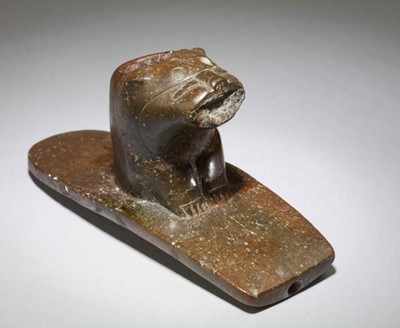Our pipe is about two thousand years old, which is the period from which we have the earliest evidence for tobacco use in North America. Tobacco was first cultivated in Central and South America, smoked wrapped in the leaves of other plants, and then enjoyed like a cigar. In the colder north, though, there were no wrapping leaves to be had through the long winters, so smokers had to find another way of containing their tobacco-and so they made pipes. The cigar/pipe divide seems very much to have been a result of climate.
這支2000年歷史的煙斗來自我們已知的北美最早開始吸食煙草的年代,煙草最早種植于中美與南美,當地人用其他植物的葉子將其卷起來抽,就像雪茄一般。但在較冷的北方,人們在漫漫寒冬中找不到足夠的葉子,便得用別的方式來盛放煙草,于是煙斗出現了。雪茄與煙斗之分,似乎部分是天氣造成的。
Stone pipes are found consistently in the Ohio burial mounds. This indicates, I think, that they must have had some special place in the lives of the people that made and used them. Although archaeologists haven't yet understood their precise meaning, we can get an insight into how they may have been regarded. Here's the Native American historian Gabrielle Tayac:
俄亥俄墓葬群中頻繁出現石制煙斗,表明它們曾在人們的生活中扮演重要角色。考古學家雖然還未能了解它們的確切意義,但我們已經可以根據現有的發現進行一些猜測。美洲印第安人國家博物館導覽員印第安土著歷史學家加布里埃爾塔亞克博士認為:
There's a whole cosmology and theology that go with pipes, that are extremely complex. They carry with them all of the meanings of religious teachings.They are definitely considered to be living beings that should be treated as such, rather than just objects, or even sacred objects, that particularly come alive and come into their own power when the bowl is united with the stem. There are rituals and initiations that go along with it, there are tremendous responsibilities that go along with being a pipe-carrier in particular places. I even hesitate to call them objects.
煙斗中有一整套宇宙學和神學,包含著所有的宗教意義。在印第安人眼中,它們絕不是普通物品,甚至也不是圣物,而根本是有生命的存在。斗與柄一旦合二為一,整個煙斗便有了自己的生命和力量。例如,如果一個煙斗由紅色的煙斗石制成,它便代表了水牛的血與骨。成為一個能在特殊場合攜帶煙斗的人,需要舉行重大的儀式,同時這個人得擔負起巨大的責任。我甚至猶疑是否該管它們叫物件。












